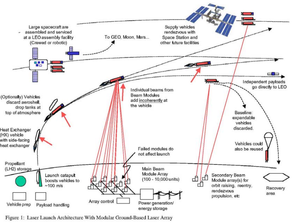
Back قوة دفع بالليزر Arabic Προώθηση με λέιζερ Greek Propulsión láser Spanish Propulsion laser French Propulsão a laser Portuguese Лазерный двигатель Russian Лазерний двигун Ukrainian
Laser propulsion is a form of beam-powered propulsion where the energy source is a remote (usually ground-based) laser system and separate from the reaction mass. This form of propulsion differs from a conventional chemical rocket where both energy and reaction mass come from the solid or liquid propellants carried on board the vehicle.
There are two main approaches: off-board, where the laser source is external to the spacecraft, and onboard, where the laser is part of the spacecraft's propulsion system. Off-board laser propulsion, which includes laser-powered launches and laser light sails, eliminates the need for the spacecraft to carry its own energy source.[1] Onboard laser propulsion involves using lasers in nuclear fusion or ionizing interstellar gas for propulsion.[1]

- ^ a b Darling, David (December 12, 2002). The Complete Book of Spaceflight: From Apollo 1 to Zero Gravity. Trade Paper Press. ISBN 978-1620458471.